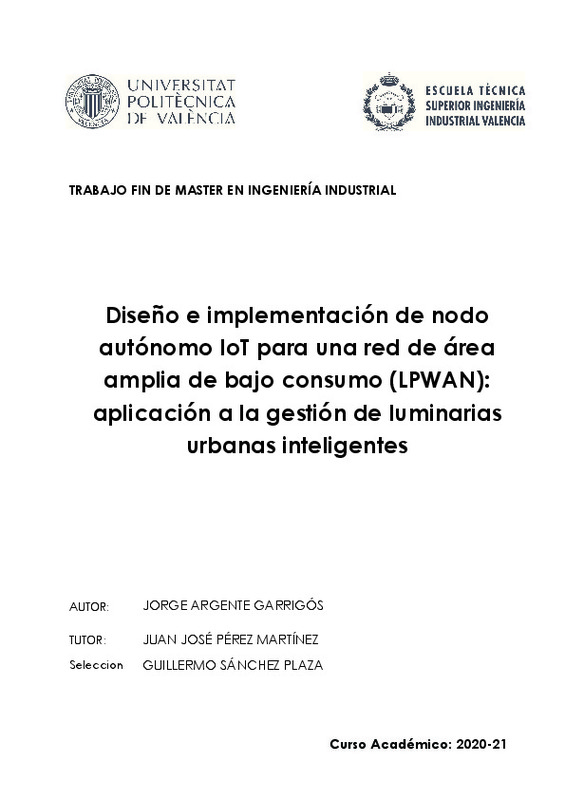|
Resumen:
|
[ES] Para lograr la gestión efectiva de sistemas constituidos por numerosos elementos dispersos sin conectividad a internet por su ubicación en zonas rurales, aisladas o despobladas, resulta de gran importancia encontrar ...[+]
[ES] Para lograr la gestión efectiva de sistemas constituidos por numerosos elementos dispersos sin conectividad a internet por su ubicación en zonas rurales, aisladas o despobladas, resulta de gran importancia encontrar soluciones de interconexión alternativas a las convencionales.
Se plantea el uso de redes en forma de malla que hagan uso de tecnologías LPWAN. Este tipo de red estaría constituido por múltiples nodos aislados y autónomos, que tengan la posibilidad de comunicarse con el resto de nodos, o con una puerta de enlace que dote a toda la red de conectividad a internet. La comunicación con los nodos permitiría la gestión, vigilancia y monitorización en tiempo real, y de forma remota, de las aplicaciones en las que se utilice. En este trabajo se va a realizar el diseño e implementación de uno de estos nodos atendiendo a los requisitos de las aplicaciones previstas.
Pueden encontrarse aplicaciones para este dispositivo en distintos ámbitos: para usos agrícolas y ganaderos sería útil como dispositivo de seguimiento para ganado, telemando de válvulas para riego o administración de químicos, monitorización de condiciones del terreno, alerta temprana contra incendios o robo de cosechas; en ciudades inteligentes para gestión de luminarias, de aparcamientos, monitorización de calidad del aire y nivel de CO2 en locales comerciales.
El objetivo es diseñar un dispositivo inteligente, autónomo, de bajo consumo energético, que pueda transmitir bajo volumen de datos a largas distancias y con capacidad de conocer y actuar con elementos del entorno. La solución adoptada debe ser una solución integrada y escalable, a la vez que flexible, para permitir su uso en distintas aplicaciones. Además, el hecho de que, una vez el dispositivo diseñado haya sido desplegado en el campo, se encuentre en localizaciones aisladas y en situación desatendida, obliga a tomar en consideración que las posibilidades de realizar mantenimiento serán limitadas, aun cuando se encuentre en condiciones hostiles, como son la exposición a la lluvia, el polvo o la intemperie.
El resultado del proyecto será una tarjeta de circuito impreso funcional, basada en un microcontrolador, que cumpla los objetivos expuestos. Posteriormente se fabricará en el laboratorio una maqueta de aplicación para smart lighting, en la que se gestione una luminaria LED y se realizarán pruebas de campo con la tarjeta para verificar el éxito del proyecto.
[-]
[EN] To achieve effective management of systems made up of a set of dispersed elements without internet connectivity due to their location in rural, isolated or unpopulated areas, it is of great importance to find alternative ...[+]
[EN] To achieve effective management of systems made up of a set of dispersed elements without internet connectivity due to their location in rural, isolated or unpopulated areas, it is of great importance to find alternative interconnection methods to conventional ones.
In this work is proposed the use of mesh networks that make use of Low Power Wide Area Network (LPWAN) technologies. This type of network would be made up of multiple isolated and autonomous nodes, which have the possibility of communicating with the rest of the nodes, or with a gateway that provides internet connectivity to the entire network. The communication with the nodes would allow the management, surveillance and monitoring in real time, and remotely, of the applications in which it is used. The design and implementation of one of these nodes will be carried out in this work. This will be done taking into account the requirements of the planned applications.
Applications for this device can be found in many different areas: for agricultural and livestock uses it would be useful as a tracking device for livestock, remote control of valves for irrigation or for chemical administration, ground condition monitoring, early warning against fires or theft of crops; in smart cities for lighting or parking management, air quality and CO2 level monitoring.
The goal is to design an intelligent stand-alone device, with low energy consumption, which can transmit a low volume of data over long distances, and with the ability to know and act with elements of the environment. The adopted solution has to be an integrated and scalable one, as well as flexible, to allow its use in different applications. In addition, the fact that once the designed device has been deployed in isolated locations and in an unattended situation, makes it necessary to take into account that the possibility of carrying out maintenance works will be very limited. This is a matter of great importance if the device is exposed to hostile environments such as rain, dust or bad weather situations.
The result of this work will be a functional printed circuit board based on a microcontroller that meets the stated goals. Subsequently, an application model for smart lighting will be set-up in the laboratory; a test fixture in which an LED luminaire is managed by means of the designed device. Field tests will be carried out with the manufactured device to verify the success of the project.
[-]
|







